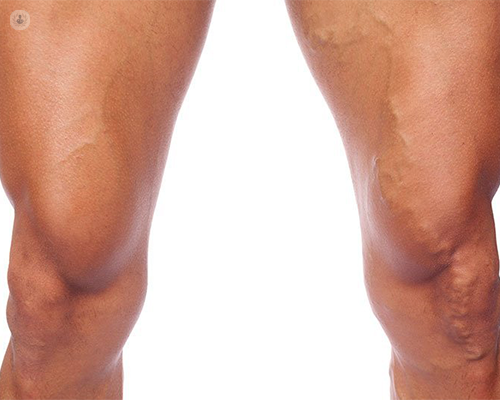What are varicose veins, and what causes them?
Autore:Top Doctors recently chatted with revered consultant vascular surgeon, Mr Maziar Mireskandari, who, here in one of our latest articles, describes what varicose veins are, and outlines the main causes.

What are varicose veins?
In normal settings, leg veins carry blood back to the heart. There are two systems of veins: the superficial (under the skin) and the deep veins within the muscles of the legs. All veins have one-way valves within them. The contraction of the leg muscles pumps the blood towards the heart during walking or exercise. The normal valves prevent the blood coming down the leg again.
Varicose veins occur when the valves become incompetent and their leaflets do not meet in the centre. Therefore, some of the blood being returned to the heart simply falls back down the leg, which is referred to as reflux.
When this reflux process takes place in the superficial veins, the veins become increasingly distended, and therefore more visible and wavy under the skin. This is a vicious circle which makes reflux worse, and as the veins increase in diameter, they become more varicosed.
What are the main causes of varicose veins?
In many cases, a definitive cause is not found. Having said that though, it is said that age, being female, a family history of varicose veins in the family, previous pregnancies, obesity, and having a profession involving standing all play a role in causing varicose veins.
Other recognised causes may be obstruction to venous flow in the deep system in pregnancy, or in conditions such as pelvic tumours and deep vein thrombosis (DVT). Under these circumstances, the blood is diverted from the deep system to the superficial system making it more distended. Varicose veins in young people may be caused by congenital abnormalities such as Klippel-Trenaunay syndrome.
What’s the best type of surgery for varicose veins?
Once superficial veins become varicosed as a result of incompetent/refluxing valves, the only definitive treatment is to remove the incompetent vein either by traditional (open) or endovenous (minimally invasive) surgery.
As such, the surgical treatment of varicose veins is performed by removing or obliterating these superficial veins. Newer techniques of minimally invasive endovenous surgery (laser EVLT or radiofrequency VNUS ablation techniques) have replaced conventional open surgery and are now the standard.
The concept of minimally invasive surgery (endovenous surgery) is to replicate the effect of surgery in removing the vein from the circulation by irreversibly stopping the flow of blood through the vein. Successful endovenous ablation requires irreversible injury (using heat or chemical) to the inside of the vein leading to occlusion. The occluded vein scars and shrinks, and eventually disappears with time.
The minimally methods (such as EVLT, radiofrequency, and the newer venaseal technique) of treating veins are generally less invasive and have the following potential benefits:
- procedure can be carried out under local anaesthesia
- patients experience less post-operative pain and bruising compared to surgery
- the patients are allowed (and in fact are encouraged) to start walking almost as soon as the procedure is completed.
- good cosmetic outcome with no surgical scarring in the groin
Is varicose veins surgery serious? Does it hurt?
Compared to the outdated conventional open surgery, the endovenous techniques are minimally invasive, much better tolerated, and have quicker recovery. In fact, most patients have this treatment on an ambulatory basis. In other words, they walk into the clinic and walk away shortly after the treatment.
The treatment is performed under local anaesthetic and involves making a needle puncture in the leg to place the laser or radiofrequency fibre, followed by several small injections of anaesthetic solution along the inner thigh. Following this, the vein is destroyed by heating it from the inside.
This is a perfectly safe treatment which has been performed for the past 20 years with very good outcomes. The vast majority of patients tolerate the injections without any issues. For those who wish to keep the number of needle injections to a minimum, there is the venaseal technique which only uses one puncture to pass the device for injection into the vein.
Although the endovenous techniques are much less painful compared to open surgery, some pain is experienced after the surgery. This is due to the damage caused to the vein by heat or other means of closure. This type of pain responds well to simple painkillers such as paracetamol or non-steroidals and simple compression stockings. Most people report being able to continue their daily activities almost straight after surgery and are pain free after five to seven days.
How long does it take to recover from varicose veins surgery?
Although some pain is experienced for up to five to seven days after the procedure, most people report being able to complete their day-to-day activities almost immediately after surgery. It is recommended to avoid strenuous physical activity and exercise moderately during this period.
Inflammation and bruising take about two weeks to completely subside. Light exercise or swimming is permitted and encouraged. Following this, some patients may experience mild twinges of pain on stretching the leg for up to six weeks after surgery.
Mr Maziar Mireskandari is a highly revered consultant vascular surgeon. Consult with him today via his Top Doctors profile.



